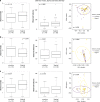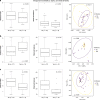Development of gut mycobiome in infants and young children: a prospective cohort study
- PMID: 36670159
- PMCID: PMC10382308
- DOI: 10.1038/s41390-023-02471-y
Development of gut mycobiome in infants and young children: a prospective cohort study
Abstract
Background: The composition of the gut fungal microbiome, mycobiome, is likely associated with human health. Yet, the development of gut mycobiome is poorly understood in infants and children. Here we investigate how perinatal events influence the development of gut mycobiome.
Methods: In this prospective cohort study of 140 infants, we used ITS gene sequencing of fecal samples from birth to the age of 18 months. We compared gut mycobiome composition according to delivery mode and exposure to intrapartum antibiotics during vaginal delivery.
Results: At birth, gut mycobiome were dominated by the genus Candida, at 6-month stool samples by Malassezia and Cystofilobasidium, and the 18-month stool samples by Trichosporon and unidentified fungi. Perinatal factors altered mycobiome. At 18 months, gut mycobiome of infants born vaginally consisted mostly of Trichosporon (32%) and unidentified fungi (31%), while those born via Cesarean section delivery samples had mycobiome dominated by Saccharomyces (50%). At the age of 18 months, those exposed to intrapartum antibiotics had mycobiome dominated by Trichosporon (66%) not seen in those unexposed to antibiotics.
Conclusions: Delivery mode and exposure to intrapartum antibiotic prophylaxis were markedly associated with gut mycobiome composition from birth to 18 months of age.
Impact: The composition of the gut mycobiome is likely associated with human health. Yet, the development of gut mycobiome is poorly understood in infants and children. In this prospective cohort study, delivery mode and exposure to intrapartum antibiotic prophylaxis were markedly associated with gut mycobiome composition from birth to 18 months of age. The impact of intrapartum antibiotic prophylaxis on fungal microbiome in vaginally born infants, previously shown to influence gut bacteriome composition, may be explained by the interaction between bacteria and fungi. Gut mycobiome composition likely deserves further investigation in relation to gut microbiome and health in children.
© 2023. The Author(s).
Conflict of interest statement
The authors declare no competing interests.
Figures





References
-
- Gutierrez MW, Arrieta M-C. The intestinal mycobiome as a determinant of host immune and metabolic health. Curr. Opin. Microbiol. 2021;62:8–13. - PubMed
Publication types
MeSH terms
Substances
LinkOut - more resources
Full Text Sources

